Timothy Riesterer's Blog, page 11
August 16, 2018
One-Size-Does-NOT-Fit-All
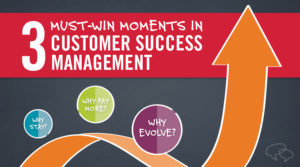
New customer acquisition and demand generation just seem to get all the love when it comes to commercial spend and resources. Meanwhile, the vast majority of company revenue and growth in a given year will come from existing customers.
The result? Typically, customer success programs have to settle for using commercial content from the customer acquisition side, or improvise their own communications with a comparably limited budget.
In fact, nearly half of companies surveyed by Corporate Visions invest less than 10% of their marketing budgets in messaging and content in key customer success situations like renewals and upsells. Meanwhile, less than half make the effort to develop customized content for these selling situations, with the majority using the same messages regardless of the customer relationship. Basically, customer success teams are put in the position of having to fight for approaches and tools that are tailored to their objectives and outcomes.
Despite all this, customer success has emerged as a key growth engine—a separate category that demands attention. Its rise in stature comes in the wake of research that continues to validate its importance, including a well-publicized finding from Bain & Company which found that a 5% boost in customer retention could increase profits by 25% or more.
As customer success becomes a main stage act, the question is whether it should be treated the same as customer acquisition or as a separate category—an area of business requiring distinct messaging, content, skills competencies, and coaching strategies.
It’s worth asking, for instance, if the same training approaches and messaging techniques that work for new customer acquisition hold up in a customer success context—when you need to renew customers, get them to pay more, and expand the relationship? Or do these situations have their own unique pressures and demands—their own distinct buyer psychology—that customer success teams need to understand and tap into?
Just because the majority of companies—58%, according to a Corporate Visions survey—see no need to differentiate their messaging and content between new customer acquisition and customer retention/expansion doesn’t mean a one-size-fits-all approach is right. In fact, research reveals it’s quite wrong. Customer success does require a distinct messaging and customer conversation approach, because the demands of the key customer success situations are radically different from that of new customer acquisition. Treat them the same at your peril.
This eBook explores how to navigate three must-win customer success moments—renewals, price increases, and upsells. And, it provides three science-backed, tested and proven approaches to handling these conversations deftly.
The post One-Size-Does-NOT-Fit-All appeared first on Corporate Visions.
July 26, 2018
Research Preview: To Add “Friction” to Sales Calls, Or Not?

At a time when 61% of respondents conduct at least half of their meetings over the phone on on the web (and 38% conduct more than 75% of their conversations in these non-face-to-face environments), it’s clear that “virtual” sales calls are a big deal.
But what’s the best approach for being memorable and compelling in these environments? How, in other words, do you gain an edge? Is it simply about modifying existing engagement techniques to a phone or web conference setting, or do these environments demand a total rethink in terms of message delivery?
This article, published in the International Journal of Sales Transformation, is part one of a two-part series addressing these key questions—and previewing original research Corporate Visions conducted in partnership with Dr. Nick Lee, a professor of marketing at Warwick Business School in Coventry, U.K.
The post Research Preview: To Add “Friction” to Sales Calls, Or Not? appeared first on Corporate Visions.
July 19, 2018
Value Delivery Tips for Successful “Virtual” Sales Calls

In the 60s and 70s, the Bell phone system had a catchy commercial slogan I remember to this day: “Long distance. It’s the next best thing to being there.” It was all about extolling the virtues of connecting with far away loved ones via super expensive long distance phone calls.
It made me wonder if that jingle still rings true today when it comes to how inside sales reps—and increasingly outside ones—are spending more time connecting with prospects and customers remotely versus face-to-face.
In a recent survey conducted with InsideSales.com, we asked more than 300 inside and outside salespeople about their “virtual” sales conversations. On average, 61% of respondents conduct at least half of their meetings over the phone or web. A significant slice—37%—conduct 75% or more of their conversations in non-face-to-face environments.
Whether it’s inside or outside sales reps, one thing is clear: virtual sales calls are a big deal. But are they “the next best thing to being there?”
There are many opinions, but not much actual research—until now.
In collaboration with the International Journal of Sales Transformation and Dr. Nick Lee, a professor at Warwick Business School, we conducted a research simulation designed to answer one pivotal question: How do you become more remarkable and compelling in phone or web conference selling environments?
Our new report, produced in partnership with InsideSales.com, covers that research and all its implications for your virtual conversations. The results break with much conventional wisdom about selling in these environments—and chart a new path forward to increase value communication when your prospects and customers are not in the same room with you.
To Increase Value Delivery, View the report for Successful Sales Call Tips:
Report: The Next Best Thing To Being There

How to dramatically improve your “virtual” sales meetings
In the 60s and 70s, the Bell phone system had a catchy commercial slogan I remember to this day: “Long distance. It’s the next best thing to being there.” It was all about extolling the virtues of connecting with far away loved ones via super expensive long distance phone calls.
It made me wonder if that jingle still ring true today when it comes to how inside sales reps—and increasingly outside ones—are spending more time connecting with prospects and customers remotely versus face-to-face.
In a recent survey conducted with InsideSales.com, we asked more than 300 inside and outside salespeople about their “virtual” sales conversations. On average, 61% of respondents conduct at least half of their meetings over the phone or web. A significant slice—37%—conduct 75% or more of their conversations in non-face-to-face environments.
Whether it’s inside or outside sales reps, one thing is clear: virtual sales calls are a big deal. But are they “the next best thing to being there?”
There are many opinions, but not much actual research—until now.
In collaboration with the International Journal of Sales Transformation and Dr. Nick Lee, a professor at Warwick Business School, we conducted a research simulation designed to answer one pivotal question: How can you be the most remarkable and compelling in phone or web conference selling environments?
Our new report, produced in partnership with InsideSales.com, covers that research and all its implications for your virtual conversations. The results break with much conventional wisdom about selling in these environments—and chart a new path forward for engaging prospects and customers when they’re not face-to-face with you.
There are many opinions, but not much actual research—until now.
Get our latest State of the Conversation Report. It covers brand new research that answers one key question: What does it take to be remarkable, memorable, and compelling in phone or online environments?
The results will help you chart a new path forward for engaging your prospects and customers when you’re not in the same room as them.
View the report: The Next Best Thing to Being There
The post Report: The Next Best Thing To Being There appeared first on Corporate Visions.
June 27, 2018
The “Other” Marketing Science
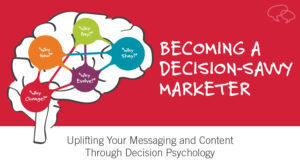
Being the VP of Marketing for a marketing and sales messaging and skills organization is not always easy. My team and I are well trained on our science-backed messaging methodologies and we are expected to utilize these messaging skills to develop world-class content and demand generation campaigns – and for the most part, I am proud to say that we do.
But, as a marketing leader, here is a cautionary tale of where I’ve dropped the ball. At the beginning of every quarter we hold a half-day team meeting to review how we performed the previous quarter and what our content and campaign strategy will be in the quarter ahead. For the first half of the meeting this last time, I reviewed metrics and measures like website traffic, inquiries, MQLs, SALs, SQLs, the performance of our tech stack etc… For the second part of the hour we previewed the campaigns we would run and what content we would develop to hit our upcoming targets. During this time, we all became engrossed in the metrics and data but unfortunately we spent NO time on our messaging. None…zilch…nada. Oh, by the way, did I mention we are a messaging company?
I only bring this up to point out that if the marketing leader for a marketing messaging company can overlook the importance of planning and developing the right messaging based on the “other” science, i.e. the science of decision making, any marketing leader can, and probably will. It’s imperative to review and plan for why your prospects and customers make the decisions they make—and to understand the buyer psychology behind the questions you need to answer at each stage of their deciding journey. This will better equip you to create the right messages and content to influence those decisions. In turn, you will produce more positive results for the metrics I mentioned above and that all of us modern marketers obsess about.
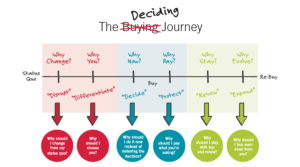
After all, there’s no shortage of ways to track and analyze customer behavior. These metrics tell you what buyers do, but they don’t tell you why they do it. That’s where the science of decision-making comes in.
To learn more about applying this science to create messages and content that influence the most important buying decisions, check out our interactive eBook, Becoming a Decision-Savvy Marketer. Learn how to infuse decision psychology into all of your most vital marketing activities by:
Matching your messages and content to the buyer psychology of the situations you face
Telling the right story when you need to win new customers, and when you need to expand with customers you already have
Creating campaigns that answer the most pivotal questions your prospects and customers are asking
Great marketing has always, first and foremost, been based on the ability to tell a great story, at the right place and at the right time. Somewhere along the way, between tech stacks and lead waterfalls, many of us have forgotten that the story we tell is still the most important part of our job and ultimately what will set us apart from our competition. Hopefully my story will help you remember to master yours.
Want to learn more? Get the eBook.
The post The “Other” Marketing Science appeared first on Corporate Visions.
May 31, 2018
From Offline to Online to Inline Learning
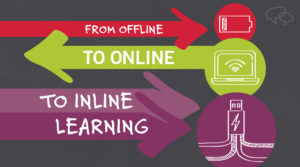
Most training and learning efforts are based on clusters of competencies, supported by a curriculum or catalog that gets scheduled on calendar-based interest and availability. But this conventional approach, and the premises underlying it, raise a crucial performance question: What does it really have to do with helping a company’s business strategy, responding to shifting market demands, or intervening to fix acute, emergent needs when they arise?
Just think about all the situations that might crop up suddenly, presenting challenges that you need to address right away. And then think about how well your training program can or can’t respond to them. These situations might include:
Troubled territory – What if a particular sales territory or geography is struggling with an aggressive competitor?
Weak pipeline or stalled deals – What if a large group of salespeople are struggling to create enough pipeline or get enough deals across the line?
Threat to a dominant product or service – What if a competitor launches a broadside on one of your highest share, highest margin product lines and you need to defend, retain and protect your position?
New product or go-to-market strategy launch – What if you need to take some competitive share or enter a new geography with a new product or program?
The main challenge when it comes to these situations? None of them are easily addressed by the traditional learning programs employed by many companies—programs that rely on catalogs of content just waiting around for someone to raise their hand and schedule an event. The future of learning and development will need to be as dynamic as the business challenges you confront. That puts a whole new set of demands on your library of competencies and content, not to mention your modes and timing of delivery.
Offline – Online – Inline
In the old days, training was primarily an offline activity. Whether it was a training workshop, a product launch, or a messaging rollout, the activity was event-based, non-virtual and done in isolation. Limiting right?
The next step was to migrate these activities to an online sphere. While a crucial phase of progress, the shift to online didn’t necessarily eliminate the inefficiencies and fragmentation that had dogged your offline efforts. After all, virtualizing classroom-based training and messaging rollouts doesn’t change their event-based character and the drawbacks that might stem from it.
That move from offline to online did, however, set the stage for the next big leap forward in your learning efforts. What I call “inline” training and learning. This approach takes training to a new level of flexibility, customization and situational relevance, helping you stand up training experiences at a moment’s notice to solve problems as they arise. Inline training is about getting your reps the messaging and skills they need, exactly when they need them.
That means messaging and skills that are inline with:
The business initiatives you’re implementing
The conversations your reps are having
The systems and technology your reps are using
The decisions your prospects and customers are making
Excel at serving existing accounts and securing renewals, but worried that won’t get you the revenue growth you need? You can stand up a multi-week, multi-touch training program to build fluency in the skills needed to disrupt and dislodge competitors, which leads to acquiring new customers.
Updating a product in a market where you have dominant share, and need to promote your upgraded solution aggressively and convince customers to pay more for it? Your reps need situational skills training to help them effectively communicate a price increase during renewal conversations, without putting your customer base at risk.
You get the idea. This is “just-in-time” problem-centric training mapped to the problems you need to solve now, as opposed to “just in case” program-centric training, based on calendars and catalogs.
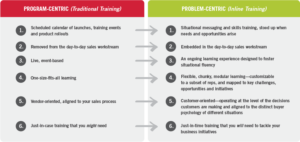
Your reps shouldn’t have to wait for training when you have a big opportunity or performance challenge that you need to address now. An inline training experience brings learning where it needs to be—in the sales workstream and aligned to the problems you need to solve. Your ability to adapt your training so that you’re executing and responding to the different selling situations that surface this year can be the difference between making or missing your targets.
This article originally published in Sales and Marketing Management Magazine
The post From Offline to Online to Inline Learning appeared first on Corporate Visions.
May 7, 2018
Do Botanists, Bakers and Farmers Know More About Revenue Than You?

Think about these three things: a honeycrisp apple, a cronut and a mule. Each is an example of a hybrid that was created for a reason. The first two were developed purely in the interest of deliciousness. And the mule, a cross-breed of a donkey and a horse, has been shown to be superior in the areas of feeding, health, sure-footedness and intelligence.
Needless to say, there are many examples of creative combinations serving as the key to improvement and evolution. It turns out this idea extends to complex sales.
When it comes to invention in the sales domain, there are three critical questions to consider:
Is there a current need?
What are the current limitations?
What is the most effective alternative?
Let’s explore each of these questions as they relate to sales messaging throughout the customer lifecycle.
Is there a current need?
Sales is a continuum of conversations. On one side, you have customer acquisition. These are prospects you want to convert into customers. On the other side, you have customer retention and expansion. The customers you have, want to keep, and expect to grow with.
Both sides of this continuum have distinct buyer psychologies—meaning that the stories and skills you need when you’re trying to acquire new customers is dramatically different from the stories and skills you need when you’re trying to retain or expand with existing customers. Research shows that you need a great ”Why Change?” story for customer acquisition and a great “Why Stay?” story for retention.
So, what’s the need? The real unknown lies between these two sides—in what’s traditionally thought of as an upsell conversation.
Imagine you’ve successfully acquired a customer, but you don’t want them to just stay and keep buying the same things from you. You want them to migrate to buying higher-value, upgraded solutions and services. You want them to evolve.
What’s the most effective type of message in this grey area? The traditional thinking is that you should challenge your customer. But that flies in the face of research showing that this provocative approach—proven to be effective when you’re the outsider—is not scientifically effective when you’re the incumbent. So what’s going to work best in this upsell situation—or what might be thought of as your “Why Evolve?” story.
What are the current limitations?
When you’re talking about a selling dialogue this important, it’s unwise to leave it up to good feelings and guesswork. That’s why we conducted a test with Dr. Nick Lee, a professor at Warwick Business School in Coventry, U.K., to determine the most effective message type for this situation. What we found initially is that in the under-researched area of customer expansion, a provocative “Why Change?” message outperformed the “Why Stay?” customer retention message across several key categories, including:
Credibility
Innovative thinking
Vendor excitement for bringing the solution to their attention
Importance to future success
How unusual or unexpected the message was
How convincing the message was
Impressive list, right? But it doesn’t tell the whole story. Because in the same test, the more protectionist “Why Stay?” message outperformed the provocative alternative in some areas of its own, including:
Trustworthiness
Likelihood of purchasing
Confidence in the decision
Pitch quality
Uniqueness
Trusted advisor status
So while the customer acquisition and customer retention messages showcased their strong suits, it still seemed like something was missing. So we wondered: Would it be possible to fashion a new message type that outperformed both of these? That’s the challenge we took on when trying to test and create the most effective “Why Evolve?” message.
What is the most effective alternative?
A hybrid. When the cronut was invented it was named one of the greatest inventions of the year by Time magazine. And honeycrisp apples have become so popular that they now account for 24 percent of all apple sales in the US. The “winning” hybrid our research yielded is a message framework called “Why Evolve?”
Okay, so we may not be holding our breath for an award from Time Magazine (although we wouldn’t turn down any hardware). But this message framework has some tremendous potential for the marketplace. Let’s take a look at what the hybrid elements of this new message are, and how they relate to the upsell situation at hand.

First and foremost, you’re the incumbent, so use that to your advantage. You know the customer. You have a privileged understanding of their situation, their limitations, their ambitions. What this research shows is that buyers will respond to you favorably if you build this understanding into your message. Show you know them. Show you understand their business. Show you are unafraid to have honest and difficult conversations.
These elements of the message are more closely aligned with the “Why Stay?” dimension of this story. But there’s more to it than that. Because you can’t just be content with the status quo. You need to upsell them. You need to drive some degree of change. To do this, you have to show that there are deficiencies in their current approach. You have to show that the status quo you helped create is not evolving at the pace of change. You have to show that there is real risk if the customer can’t evolve and keep up. These can be difficult conversations to have with a customer, but if you create the right foundational base that begins with reinforcing your relationship, it will enable you to share these hard truths with your customer in a way they will appreciate. And that will motivate them to buy.
Hybrids can be scary, especially when they appear to combine two dramatically different things. That characterizes the winning “Why Evolve?” message to a T. But, if you are willing to consider that a marriage of opposites can unearth new possibilities that have yet to be executed effectively in marketing and sales, then you have the opportunity to win more upsell business. And as far as your wallet goes, the result will be sweeter than a honeycrisp.
Get the full “Why Evolve?” research and analysis in this report.
The post Do Botanists, Bakers and Farmers Know More About Revenue Than You? appeared first on Corporate Visions.
April 20, 2018
What’s the Best Approach for Upselling Customers to Upgraded Solutions?
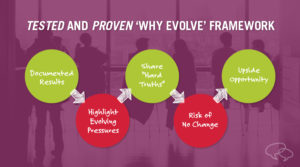
“But how do we sell in this situation?”
Research has a way of begetting more research. As soon as we conduct a study that illuminates how to address a certain moment in the purchase cycle, another customer comes along wondering how to handle a different selling scenario.
Once our research revealed the best message for when you’re the outsider trying to defeat the status quo (“Why Change?”), we started hearing from folks wondering what to do when they are the status quo (“Why Stay?”). The big discovery here was that the disruptive message you need to dislodge an incumbent vendor is essentially the opposite of the message you need when you’re trying to retain existing customers.
These studies covered a lot of terrain in the customer lifecycle—two huge moments in the areas of customer acquisition and customer expansion. But as we soon discovered, there were still gaps in the research—other key moments and questions whose buyer psychology profiles needed to be better understood.
One of those questions was this: How do you sell more to an existing customer? How do you address what is traditionally known as an upsell conversation, when you might need to convince customers to migrate to higher-value solutions, whether in the interest of a significant upsell opportunity or because of a material change to a base product?
This moment we’re calling the “Why Evolve?” story. While it seems like it should be relatively easy to convince customers to migrate to higher-value solutions, it seldom is. A Corporate Visions industry survey found that:
Nearly 60 percent of respondents are only somewhat satisfied or worse when it comes to how well they convert customers to new solutions—both in terms of how fast they convert them and how many are converting.
That’s a problem. Because the survey also found that 86 percent of respondents say this situation is “important” or “very important” to their revenue success and their ability to retain customers.
There’s a lot on the line in the “Why Evolve?” moment. If you’re successful, you create a foundation for better customer experiences and longer-lasting partnerships. If you slip up, your partnerships and revenues stagnate. And those aren’t your only problems…
If you aren’t providing your customers with the most exceptional experiences, you become vulnerable to disruption from competitors who will claim they can. They could even disrupt you out of the equation with promises of superior customer experiences that they can deliver. The issue isn’t so much that you don’t have those capabilities—it’s that you haven’t seized the opportunity to provide them.
That’s what’s at stake. Besides these threats, another reason this moment calls for research is that, on its face, it appears to require something of a hybrid between the “Why Change?” and “Why Stay?” stories. In any case, a moment this important shouldn’t demands more than guesswork or hunches about what might work best. That’s why we put it to the test in brand new research, covered below.
Researching the “Why Evolve?” Moment
For this research we collaborated with Dr. Nick Lee, a Professor at Warwick Business School who has spent nearly 20 years drawing from social psychology, cognitive neuroscience, economics, and philosophy, to develop insights into salespeople and selling.
Our goal was to design a study that responds to the most pressing challenges salespeople face when trying to upsell new solutions to existing customers. There are five main challenges:
Different enough? It’s hard to be seen as different enough to require action. How do you create a message that’s not what the customer expects—that’s unusual enough to generate interest?
Important to success? A big part of selling is creating a buying vision in the minds of your customers. How do you craft a message that gets them to see your solutions as vitally important to a vision where they are successful?
Personally convincing? How do you craft a message that not only shows the value of their business, but also convinces them to become personally invested in propelling that business forward?
Willingness to change? With so many priorities in play, buyers need to be willing to take this on and embrace change. How do you craft a message facilitates that?
Intention to purchase? Ultimately, the only thing that matters is whether they purchase or not. How do you craft a message that increases the likelihood of your customer actually buying?
The best message for the “Why Evolve?” moment is one that’s most effective at helping salespeople excel in these areas. Here’s how we set up the study to determine what that message looks like.
The study, conducted online, included 426 participants whom we put into a business-to-business decision-making simulation.
At the outset, participants were randomly assigned to a range of different test conditions. All were told to imagine they were decision-makers in a conversation with a sales rep from their long-term software vendor. The rep is trying to convince them to upgrade from a legacy on-premise version of their business intelligence software to their new cloud-based business analytics solutions.
The five conditions tested include the following message types, summarized below:
Product as the Hero – This was based on the type of message many companies use to announce new solutions. It’s product-oriented and focused on highlighting the new and improved features and benefits.
Relationship Reinforcement and Emotion – This message uses emotional language to emphasize the idea that the company and vendor are partners. It’s open about having a frank conversation about the challenges and opportunities in a long-term partnership.
“Why Change?” – This message has already been proven in our past research to be the message for converting new prospects into customers. It’s disruptive, edgy, and we wanted to test it out in this scenario.
“Why Stay?” – Our previous research confirmed this message is best for convincing existing customers to renew. We wanted to see how it would hold up in the middle of an existing customer contract, with an upsell in play.
Social Influence – The premise of this message is that peer pressure is a powerful motivator. This condition shows the buyer that many of their peers are making strides and they can’t afford to get left behind.
After experiencing their respective messages, participants answered a series of questions designed to assess how well the messages performed relative to the challenges highlighted above.
The Best “Why Evolve?” Message
The most effective message across the key areas assessed was the relationship reinforcement and emotion condition, which consistently outperformed the others.

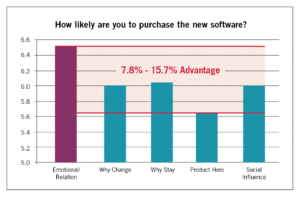
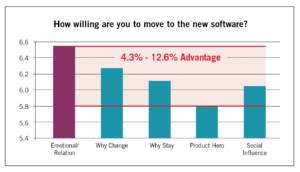
The winning condition is something of a hybrid message, borrowing elements from the disruptive “Why Change?” approach and from the more protectionist “Why Stay?” one. An important implication is that this hybrid message—rather than a message that strictly challenges their situation—is optimal for performing well in an upsell or cross-sell scenario.
And that makes sense. This message isn’t designed for driving big, disruptive changes or getting a customer to renew. It’s about getting a customer to evolve their vision and their buying habits. This message, summarized in the visual below, ensures customers don’t fall back on using your old guard solutions instead of your newest and highest-value innovations.

Don’t leave this message to chance—not when the upside of handling the “Why Evolve?” moment well is so key to your success. By applying this research to your upsell and cross-sell conversations, you’ll stand the best chance of being the vendor who provides the top-notch customer experiences your buyers need to perform.
To get the full study results and additional analysis on the findings, check out our latest State of the Conversation Report
This article originally published in Sales & Marketing Management Magazine
The post What’s the Best Approach for Upselling Customers to Upgraded Solutions? appeared first on Corporate Visions.
April 3, 2018
How to Up-Skill Medical Device Sales Reps: Carpets vs. Clinics (Part 2)

In the previous post, you learned about the hypothetical Sarah, an experienced medical device sales rep who has run into trouble closing deals. Seismic changes in healthcare purchasing are driving her out of her clinical comfort zone and towards unfamiliar executive audiences in the carpeted areas of the hospital. If you support or manage reps like Sarah, you need to think about upgrading selling skills for business-focused buyers who are becoming more involved in purchasing decisions.
Does this mean that all selling will happen “on the carpet”? Will your team no longer use the clinical skills they’ve worked so hard to develop? No. In fact, success will depend on being confident, competent, and compelling in all environments. That’s because, according to Boston Consulting Group, everyone buys differently: “Hospital systems have strikingly different procurement practices, with some allowing the preferences of individual clinicians to drive purchasing decisions, while others employ highly centralized purchasing processes”. Clinical selling isn’t going away. But reps will have to adjust their mix of clinical and business selling strategies on a customer-by-customer basis.
Experienced salespeople come to Corporate Visions for the skills to survive – and thrive – in this new world. They often arrive at our programs with their confidence shaken by a few rough quarters. One pined for the days when success meant “buddying up to the surgeon.” Another spoke of difficulties finding the person with the right level of influence and wasting time with stakeholders who turn out to have no purchasing authority. Working with us, salespeople learn to supplement their clinical selling skills with competencies for working with cross-functional buying teams. They learn to structure their conversations around things executives care about, and to justify decisions by making a meaningful business case.
If you manage or support reps selling to healthcare buyers, here are three things to consider:
If you are like most companies, you are preparing salespeople for the conversation executives don’t want to have.
Most salespeople have a limited number of executive contacts; a lack of confidence keeps them from getting more.
Engaging executives comes down to a handful of critical competencies that sellers can learn without going through time-intensive training programs.
You don’t have to send them to business school. You don’t even have to take them out of the field. Instead, you can build out the skills of your clinical selling stars with programs that accommodate your training constraints—programs including:
One- or two-day in-person events that include live role-plays.
Online learning with interactive knowledge checks and simulations.
Video-based coaching with detailed feedback and remediation plans.
Upskilling and Training Conclusion
Fast forward six months and things are on the upswing for Sarah. She developed executive selling competencies through a multi-touch learning plan for justifying value to business-buyers. She’s received individualized feedback on her use of planning tools, her presentation skills, and her performance in role plays. Her manager now has enhanced coaching skills and is giving her actionable feedback on a weekly basis. She’s cementing these positive behavior changes through spaced reinforcement techniques, helping her internalize skills and concepts that are tailored to her specific learning needs. And she’s accomplished all of this without having to leave the field for a single training event. Most importantly, instead of dreading meetings with client buying teams, she’s looking forward to conversations in the carpeted areas of the hospital.
In our next post, we’ll talk about three strategies for making salespeople more adept at selling in the carpeted areas of the hospital.
Learn about research that produced a tested and proven framework for helping salespeople avoid stuck deals and make a more compelling executive-level business case. Check out the report.
Learn how to stand up training programs that equip your reps with the skills they need, exactly when they need them—and without taking them out of the field. Get the eBook.
The post How to Up-Skill Medical Device Sales Reps: Carpets vs. Clinics (Part 2) appeared first on Corporate Visions.
Carpets vs. Clinics (Part 2) – How to Up-Skill Your Reps
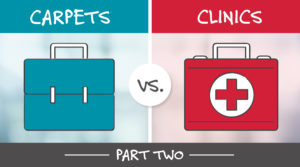
In the previous post, you learned about the hypothetical Sarah, an experienced medical device sales rep who has run into trouble closing deals. Seismic changes in healthcare purchasing are driving her out of her clinical comfort zone and towards unfamiliar executive audiences in the carpeted areas of the hospital. If you support or manage reps like Sarah, you need to think about upgrading selling skills for business-focused buyers who are becoming more involved in purchased decisions.
Does this mean that all selling will happen “on the carpet”? Will your team no longer use the clinical skills they’ve worked so hard to develop? No. In fact, success will depend on being confident, competent, and compelling in all environments. That’s because, according to Boston Consulting Group, everyone buys differently: “Hospital systems have strikingly different procurement practices, with some allowing the preferences of individual clinicians to drive purchasing decisions, while others employ highly centralized purchasing processes”. Clinical selling isn’t going away. But reps will have to adjust their mix of clinical and business selling strategies on a customer-by-customer basis.
Experienced salespeople come to Corporate Visions for the skills to survive – and thrive – in this new world. They often arrive at our programs with their confidence shaken by a few rough quarters. One pined for the days when success meant “buddying up to the surgeon.” Another spoke of difficulties finding the person with the right level of influence and wasting time with stakeholders who turn out to have no purchasing authority. Working with us, salespeople learn to supplement their clinical selling skills with competencies for working with cross-functional buying teams. They learn to structure their conversations around things executives care about, and to justify decisions by making a meaningful business case.
If you manage or support reps selling to healthcare buyers, here are three things to consider:
If you are like most companies, you are preparing salespeople for the conversation executives don’t want to have.
Most salespeople have a limited number of executive contacts; a lack of confidence keeps them from getting more.
Engaging executives comes down to a handful of critical competencies that sellers can learn without going through time-intensive training programs.
You don’t have to send them to business school. You don’t even have to take them out of the field. Instead, you can build out the skills of your clinical selling stars with programs that accommodate your training constraints—programs including:
One- or two-day in-person events that include live role-plays.
Online learning with interactive knowledge checks and simulations.
Video-based coaching with detailed feedback and remediation plans.
Conclusion
Fast forward six months, and things are on the upswing for Sarah. She developed executive selling competencies through a multi-touch learning plan for justifying value to business-buyers. She’s received individualized feedback on her use of planning tools, her presentation skills, and her performance in role plays. Her manager now has enhanced coaching skills and is giving her actionable feedback on a weekly basis. She’s cementing these positive behavior changes through spaced reinforcement techniques, helping her internalize skills and concepts that are tailored to her specific learning needs. And she’s accomplished all of this without having to leave the field for a single training event. Most importantly, instead of dreading meetings with client buying teams, she’s looking forward to conversations in the carpeted areas of the hospital.
In our next post we’ll talk about three strategies for making salespeople more adept at selling in the carpeted areas of the hospital.
Learn about research that produced a tested and proven framework for helping salespeople avoid stuck deals and make a more compelling executive-level business case. Check out the report.
Learn how to stand up training programs that equip your reps with the skills they need, exactly when they need them—and without taking them out of the field. Get the eBook.
The post Carpets vs. Clinics (Part 2) – How to Up-Skill Your Reps appeared first on Corporate Visions.
Timothy Riesterer's Blog
- Timothy Riesterer's profile
- 3 followers



